
If you’re new to the world of fly fishing, likely, you’re not familiar with all the different types of trout. But how can you master the art of angling without knowing all about the species of fish that you’re hoping to catch?
The easy answer is: You can’t. Without knowing anything about the types of trout, how they behave, their habitats, what food they eat, and how they act according to the weather, your fishing trips will come down purely to a matter of luck.
After all, angling is all about understanding how the fish operates. By ensuring your bait, line, method, and tackle suitable for the fish you’re about to catch, you save yourself plenty of time and effort.
But how can you do that when you don’t even recognise the species of fish you’re looking at? It’s hard to boast about the fish you’ve caught if you don’t even know what fish it is—in the same way, genuinely grasping how trout work is the key to mastering fly fishing.
So, what are you waiting for? Let’s explore the many different types of trout so you can become a pro angler.
The Many Different Types Of Trout
Trout is a freshwater fish often used for cooking and recreational fishing. It has several types such as brown, rainbow, and golden trout, and its taste is considered one of the best among the fish species.
To understand how to catch trout, you need first to learn to identify them positively. However, it is not possible to talk about all the different species of trout in the world. So, we will discuss the species of trout that you’re most likely to see on your fishing adventures. Let’s dive in!
Brown Trout
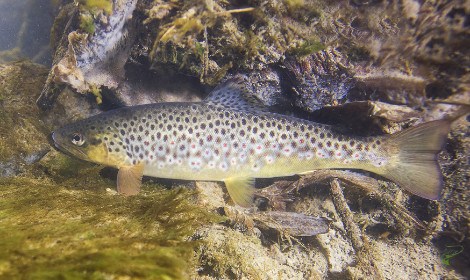
As its name suggests, Brown Trout is a brown-coloured fish that mainly inhabits deep, cold streams and lakes. Anglers can usually find this fish in places that have cover from trees or their overhanging branches. This species is considered a freshwater fish.
Anglers can find them at any water depth. However, their behaviour regarding water depth depends upon their age. Younger trout prefer to feed in shallow water close to the bank, while older trout choose to inhabit the centres of lakes and streams.
But how can you know when you’ve caught a brown trout? Let’s see.
Distinctive Features
The most common type of brown trout has a reddish-brown body. However, sometimes anglers see more silvery versions too in freshwater habitats.
An important distinctive feature of the brown trout is its long head. You can also recognize it by the black spots surrounded by lighter shades that cover its entire body.
It is usually medium-sized fish, with its length ranging between 7-39 inches. These fish can even grown up to around 30lbs but larger species in rare occasions have been recorded.
Rainbow Trout
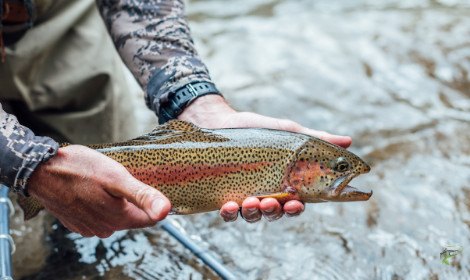
Anglers can find Rainbow Trout in waters with gravel in them, mainly inhabiting waters that provide cover as well as gravel bottoms.
They are considered an endangered species in some parts of the world due to declining populations. This fish is usually farmed as food as well.
Distinctive Features
As is evident from its name, this species of trout is known for its vibrant colours. With whitish bellies and a pink stripe running across its entire length, this fish has various colours that make it beautiful.
It has a variety of colours on it. However, adult rainbow trout is usually green or bluish. Black spots cover its body that is characteristic of some trout species. Rainbow Trout has small scales that cover its entire body.
It has a forked tail that also has some black spots on it.
Its length usually ranges between 20 to 30 inches. Rainbow Trout is known to weigh, on average, between 1-8 lb.
Golden Trout
The Golden Trout is also known as the California Golden Trout, as anglers usually find it in California. It is known for its beautiful, vibrant colours. Anglers mostly find Golden Trout in streams, rivers, and creeks.
A remarkable fact about the Golden Trout is that anglers can usually only find the wild variety at great heights. The reason is that Golden Trout only flourishes in mountainous areas that anglers cannot reach easily. They inhabit streams or rivers with tiny plantations.
Wild Golden Trout, as a species, is close to being endangered. This status is because of competition for food, mismanagement, and other such issues.
If you haven’t yet gotten tired of reading about the Golden Trout, let’s discuss some features of the Golden Trout with which you can identify them.
Distinctive Features
Golden Trout lengths range from 7-27 inches. While most are usually small in size, anglers consider those over 12 inches as large Golden Trout.
It is greenish with golden shades on its sides. This golden shade gives it the name. It also has orange-red streaks on each side of its body, with dark spots covering the entire body.
It is usually tiny in size, and its body is covered in full by small scales.
Fishermen usually see large sizes in Golden Trout in places with excellent water quality, no competition for food, and adequate opportunity to prey on smaller animals.
Tiger Trout
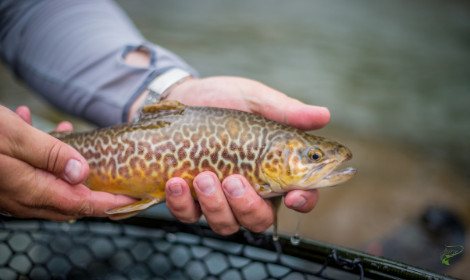
Tiger Trout is a hybrid species of trout. It is born when male Brook Trout fertilizes the eggs of a female Brown Trout. It is called Tiger Trout because of the distinctive tiger print present all over its body.
Anglers usually find this species of trout in areas where both the Brown and the Brook trout flourish at the same time.
Tiger Trout usually feeds in shallow waters. It is pretty aggressive when it comes to feeding, with baitfish being a favorite as far as the adult Tiger Trout is concerned.
It prefers clear waters over muddy ones. Tiger Trout is also sterile due to its hybrid nature, so it cannot reproduce.
So, what features can you identify this fish with? Let’s find out.
Distinctive Features
The most distinctive physical feature of Tiger Trout is the tiger pattern on its body. This pattern looks like a dark maze and makes the Tiger Trout stand out among similar fish builds.
Because of its baitfish diet, Tiger Trout can grow to enormous sizes. It is usually greenish-brown in colour. Its length usually ranges between 6 to 25 inches. It can grow from 5 lb to over 30 lb at times.
It has a lighter belly that ranges from shades of yellow to shades of white. It has a square tail fin, which is different from most other trout’s forked tail fin.
In general, they are similar in pattern and colours to the Brook Trout. However, the Brook Trout’s colouring is brighter, and the patterns are more vivid than those on the Tiger Trout.
Brook Trout
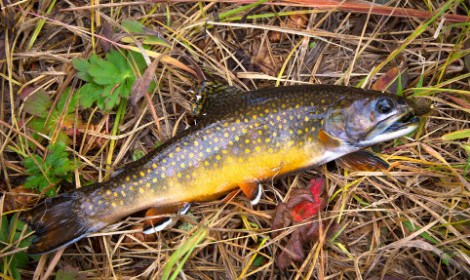
Brook Trout is a type of freshwater fish that anglers mainly find in North America and Canada. Known for its vivid patterns, most people catch this fish for both food and sport. It is a freshwater fish.
As we discussed earlier, Brook Trout’s males can cross with a female Brown Trout to produce Tiger Trout offspring that is reproductively sterile.
It is a carnivore and eats a wide range of animals such as the larva and pupa of small insects, crustaceans, adult forms of most land and sea insects, mollusks, baitfish, some species of invertebrates as well.
Brook Trout have recently seen a decline in their populations due to loss of habitat and other factors.
But what makes the Brook Trout different? How can you distinguish it from a tiger Trout? Let’s see.
Distinctive Features
The Brook Trout, similar to its hybrid offspring, is covered in vermiculation. Vermiculation is the dark irregular pattern that you can see all over its body. Its colour ranges from greenish brown to lighter shades, with the vermiculation appearing in lighter colours all over the body.
The colour of the belly ranges from light yellow to orange, depending on the season as the adult males get reddish-orange bellies during spawning season.
Its size is in the range of 10-25 inches. Some Brook Trout weigh as low as under 1 lb, whereas some weigh as much as 6 lb. Their tail fin is similar in shape to the Tiger Trout’s, as it is also square-shaped.
However, a few things can help you differentiate the Brook Trout from the Tiger Trout. The Brook Trout has a scattering along its flanks of red dots surrounded by a blue shade. The Tiger Trout does not have that.
Cutthroat Trout
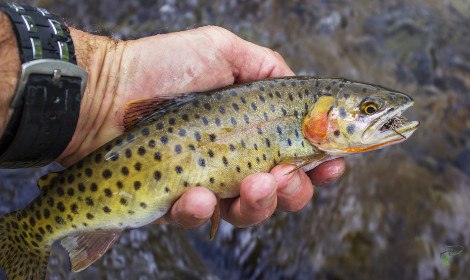
Cutthroat Trout are freshwater fish that inhabit cold streams and rivers. With a preference for cold waters, anglers usually find them in shallow water with gravel at its bottom. It is very popular among anglers who catch it for sport and consumption as food.
Cutthroat trout typically feeds on anything that it can find. Its food includes the larval, pupal, and adult forms of most insects, small amphibians, small fish, crustaceans, fish eggs, and almost all other small aquatic life forms.
Cutthroat Trout is considered the tastiest trout to eat. However, its population has been declining in recent years due to the loss of cold water habitat and overpopulation of competitive fish.
So, how do you know if you’ve caught a Cutthroat Fish? Let’s break down its defining features.
Distinctive Features
Cutthroat Trout generally have a wide range of colours and sizes. The one common factor between all the different looks is the bright red slashes under its mouth. This bright red slash is what earned this fish its name.
However, most Cutthroat Trout are in shades of green, brown, grey, or golden. Darker spots are present all over their body, with the fins being most heavily spotted.
Their bodies are kind of elongated in shape, with their lengths ranging from 6 to as long as 40 inches.
Some Cutthroat Trout can be as light as 2 lb and as heavy as 40 lb. Breeding Cutthroat Trout males generally have red gill covers and on the sides of their heads as well.
So, what’s the next trout on our list? Let’s see.
Marble Trout
Marble Trout are freshwater fish typically found in cold, fast-flowing rivers and streams. They are generally large and are known for their rapid growth. Their heads are large and can take up almost a quarter of their size.
Marble Trout are very similar to Brown Trout. It is also an endangered species. This endangerment is because the hybrids they produce with Brown Trout are fertile and compete with them for food and habitat.
Anglers usually encounter Marble Trout on riverbanks in gravelly bottoms in places such as Italy, Slovenia, Bosnia and even Montenegro. Its also omnivore in nature and feeds on a variety of plants and algae. Mature Marble Trout also feed on other fish.
Distinctive Features
Marble Trout are rounded and have a more elongated body than Marble Trout. Their heads are comparatively huge, with almost 25% of their body size taken up by their heads. They are named so because of the marble-like pattern on their body.
Sizes usually range between 12-27 inches. Anglers have encountered Marble Trout in weights in the range of 40 to 70 lb.
The colour of the marbled pattern on their body differs according to their habitat. In some waters, they are brighter with red spots whereas, in others, they have duller shades.
Well, what type of trout is next?
Lake Trout
Lake Trout is a species of trout that most people love to eat. It is a freshwater species that mainly inhabit icy waters that are high in oxygen content. They reproduce very slowly and mature slowly as well.
Many anglers also catches it for sport. Lake Trout also crosses with Brook Trout to produce genetically similar species.
When they are young, lake trout feed on algae and zooplankton. As they mature further, they feed on chub and smelt as well as small invertebrates.
So, how can you positively identify Lake Trout?
Distinctive Features
Lake Trout is usually greyish white. It has yellow or beige spots covering its entire body. It has an adipose-filled fin at the back of its body. It has a paler belly with reddish-orange fins.
Lake Trout usually come in a weight range of 6 to 40 lb. Their length is generally between 24-36 inches.
It is hard to identify Lake Trout as their appearances depend mainly on the kind of environment that they are in. This change in appearance helps Lake Trout blend itself into its surroundings in case of a predator.
It is usually similar in physique to salmon.
Well, that’s all!
How You Can Remember The Different Species Of Trout
If your head began spinning when you read through the different types of trout, you would likely have trouble remembering them. But how can you become a master angler without knowing what other trout look like? Well, there are some things you can do to jog your memory. Let’s see what they are.
- Look at pictures of all the types of trout. This tip is the most obvious yet the most important one.
- Try to focus on the trout that you catch. Identify it, take a picture of it and even note down some distinguishing features that you see.
- Always be on the lookout for more information. Even experienced anglers have trouble identifying some similar species of fish.
- Ask for help. It’s okay to ask someone more experienced than you.
Well, that’s all on how you can remember the different species of trout.
That’s All.
This article serves as an angler’s guide to some of the various types of trout inhabiting waters, and knowing all about the different fish that you catch can help you become a better angler. It can also help you remember other fish behaviours that will aid you on your fishing trips.

